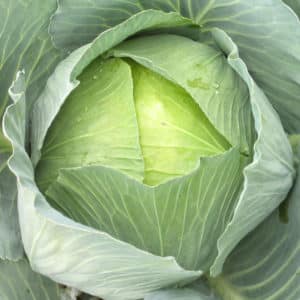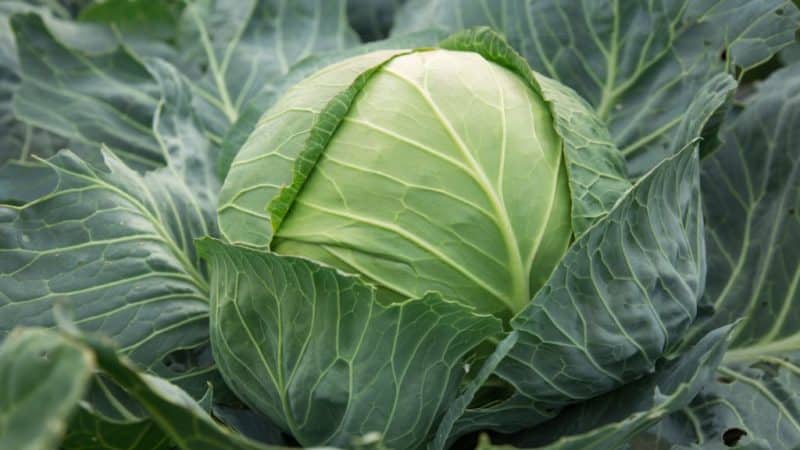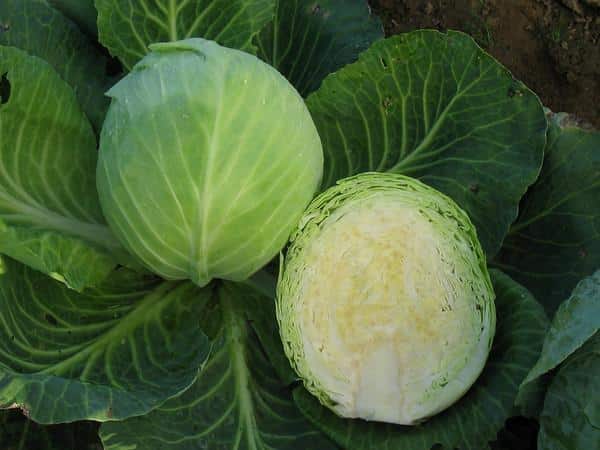Late-ripening cabbage variety Sugarloaf
White cabbage is one of the most popular vegetables for growing in the garden. Gardeners prefer disease-resistant and easy-to-care varieties. Late-ripening Sugarloaf cabbage has these properties. It also has excellent taste and is suitable for preparing for the winter, ripens in the harsh conditions of Western Siberia and is stored for a long time.
Description of cabbage variety Sugarloaf
White cabbage Sugarloaf is a late-ripening variety bred in 2008 by specialists from the Moscow company Sedek.. The region recommended for cultivation is Western Siberia. However, Sugarloaf was appreciated not only by Siberians. Soon, agricultural companies and farms located far beyond Russia began to purchase it.
Chemical composition and beneficial properties
Cabbage is a healthy and low-calorie vegetable.
100 g of product contains:
- 1.8 g protein;
- 0.1 g fat;
- 4.7 g carbohydrates;
- 27 kcal.
Sugar loaf has a high sugar content - up to 6.9 g, while in others varieties its quantity in 100 g of vegetable is up to 4.6 g.
Thanks to its rich composition of vitamins, macro- and microelements, cabbage has important beneficial properties:
- High content of vitamin C – 45 mg. It lasts until spring and strengthens the immune system.
- Antioxidants A (3 mcg) and E (0.1 mg) prevent premature aging.
- Rare vitamin U prevents the formation of stomach ulcers.Constant consumption of fresh cabbage improves the health of the gastrointestinal tract.
- Vitamin B7 (biotin) improves the condition of skin and hair.
- Potassium (300 mg) normalizes heart function and activates metabolism.
- Calcium (48 mg) strengthens bones, and phosphorus (31 mg) is responsible for healthy teeth and joints.
Cabbage also contains vitamins K and B, magnesium, iron, zinc, selenium and sodium.
Features of application
The variety is suitable for fresh consumption, pickling and salting. Cabbage retains its taste during heat treatment. During the cooking process, it does not lose density, but becomes soft and tender. Vitamin salads and snacks are often made from Sugarloaf.
Reference. Due to its high commercial quality and presentable appearance, the variety is popular among farmers. It is good for sale.
Ripening time and yield
Sugarloaf is a late-ripening variety, its ripening period is 140-150 days. Cabbage has a high yield - 6 kg per 1 sq. m.
Disease resistance
The value of the variety lies in its:
- resistance to bacteriosis, fusarium, clubroot;
- stable yield;
- long-term storage (almost until May).
Cold resistance
The variety was specially bred for cultivation in the harsh climate of Siberia, and therefore is characterized by increased frost resistance. Seedlings tolerate short frosts down to -3...-5°C. It is better to pick ripe vegetables after the first frosty days, then the taste of cabbage will become more intense. The main thing is not to overdo it and take the harvest from the field before the onset of cold weather -10°C.
Characteristics of sweet cabbage Sugar loaf
The plant has a powerful spreading rosette of leaves up to 80 cm in diameter. For this reason, Sugarloaf is not suitable for growing in greenhouses.The cabbage reaches a height of 40 cm. The variety has large, rounded, light green leaves with a slightly wavy edge and a waxy coating. The head is smooth, dense, weighing 3-3.5 kg, white in cross section. It has a short outer stalk and a medium-sized inner stalk. The vegetable tastes juicy and sweet, it contains 1.5 times more sugar than other late-ripening cabbage varieties.
Pictured is Sugarloaf cabbage.

What regions is it suitable for?
Sugarloaf was bred for cultivation in Western Siberia. But, according to reviews from vegetable growers, cabbage has taken root well in the conditions of the middle zone. The climate is changing, and in the Moscow region there are frosts on the ground in May. Therefore, more and more often, owners of household plots began to pay attention to Siberian cold-resistant varieties.
Advantages and disadvantages of the Sugarloaf variety
Sugarloaf has important advantages:
- increased sugar levels;
- absence of hard veins;
- high content of vitamins and microelements;
- long storage period without loss of taste;
- resistance to prolonged drought;
- good seed germination;
- resistance to diseases and pests;
- transportability without loss of presentation.
The variety does not have many disadvantages:
- the need to change the sown area every year;
- cabbage loves indirect sunlight (shaded areas are not suitable for planting).
Difference from other varieties and hybrids
Sugar loaf is characterized by low maintenance and long storage with relatively high yield. Hybrids Sugar Queen F1 and Sugar Queen F1 have appeared on the market. The first ripens earlier - after 120 days, the second produces heads of cabbage well in dry weather. But neither one nor the other reaches Sugarloaf in terms of taste.
Features of planting and growing
White cabbage of late-ripening varieties in Western Siberia is grown by seedlings. In the southern regions, it is allowed to sow seeds directly into open ground.

Preparatory work
Preparations for planting begin in the first ten days of April. Soil for sowing is sold in the store, but it is easy to prepare it yourself. For home growing of seedlings, the following ratios are used:
- 70% peat, 25% turf, 5% sand;
- 50% turf, 45% humus, 5% sand.
Before sowing, the soil is fertilized with urea or potash fertilizers.
Seed preparation
On the eve of planting, the seeds are placed in a solution of potassium permanganate for 12 hours, then washed with water and dried.
Important! It is better to plant seeds in peat pots. They will help avoid damage to the plant’s root system when transferred to open ground.
Planting depth is 0.5 cm. In order for the plants to sprout well, the container is placed in a draft-free room with a temperature of +21...+25°C.
Preparing seedlings
If sowing was done in a common container, 2 weeks after germination it is necessary to pick the seedlings and transfer the strong plants to separate cups. Before planting in open ground, seedlings are hardened off. To do this, it is periodically taken outside, gradually increasing the duration of the procedure to several hours. At the end of May - beginning of June, seedlings are planted in the garden. Wood ash is suitable as a fertilizer.
Important! Before planting, place a small amount of superphosphate in the hole so that the plant takes root faster.
How to plant without seedlings
Seed material can be immediately placed in open ground, but covered with film. Sowing is carried out after April 20, so that the soil warms up to +10°C.The holes are made according to a 3x5 cm pattern. This distance allows you to get a sufficient number of strong sprouts at an optimal distance from each other.
Soil requirements
Slightly acidic or neutral soil is suitable for growing cabbage. Sugarloaf is not picky about the soil, but does not tolerate sandy or marshy areas. In the fall, the soil is dug up, and organic fertilizers are applied in the spring. The area allocated for planting cabbage is fertilized with wood ash.
Predecessors
For planting Sugarloaf, a part of the garden is suitable where potatoes, legumes, cucumbers, tomatoes, beets or onions grew last season.
Important! Cabbage is not planted in the same place for 2 years in a row or after other cruciferous vegetables, as the soil is greatly depleted, and next year the harvest will be meager.
Dates, scheme and rules of planting
Seedlings are planted in open ground at the end of May - beginning of June, when the ground warms up to +15...+17°C. The soil is dug up, loosened and holes are made according to a 60x60 cm pattern, since wide and spreading rosettes form at the Sugarloaf.
Planting density and depth
Seedlings are buried in the ground up to the first lower leaf. This is done carefully so as not to fill the apical bud.
Read also:
Early maturing cabbage hybrid Krautkaiser F1
Nuances of care
The variety is demanding on lighting. If there is not enough light, the heads of cabbage will grow small and not as sweet in taste.
Watering mode
Plants are watered 1-2 times every 3 weeks. When tying heads of cabbage, the soil is moistened more often, pouring no more than 2 liters of water under the bush. If the summer is rainy, watering is reduced or stopped.They stop watering cabbage a month before harvesting to prevent the heads from cracking.
Loosening and hilling
After 10-12 leaves are formed on the seedlings, hilling is carried out. This procedure helps to form lateral roots and strengthen them. Then the soil is periodically loosened to allow the root system to breathe. At the same time, weeds are removed from the garden bed. Loosening is especially important after rain or heavy watering, when the soil becomes crusty. Hoeing must be done carefully so as not to damage the roots in the top layer of soil.
Fertilizing and other measures to increase yield
During growth, seedlings are fed with an aqueous solution of manure. Fertilizers are applied 2-3 times per season. All that is required for a high yield of cabbage is correct crop rotation, careful preparation of the soil and seeds before planting, fertilizer and fertilizing. You can increase the yield due to the number of commercially available heads. On average they are 93% due to the variety's tendency to crack. Moderate watering and fertilization will help avoid this.
Disease and pest control
The Sugarloaf variety is resistant to diseases and pests, but improper care can provoke the development of the following diseases:
- Bacteriosis. Yellowing of the outer leaves is observed, after which they darken and fall off. To prevent disease, use high-quality seeds and observe crop rotation.
- Downy mildew. The leaves are covered with a white coating. For prevention, the seeds are kept in warm water for 25 minutes before sowing, and the plants are fed with ammonium nitrate (ammonium nitrate). When infected, plantings are sprayed with copper sulfate.
- Cabbage butterfly. The affected leaves turn pale, eventually the plant dies completely.The risk of the disease is reduced by sowing dill or parsley near the cabbage bed.
- Fusarium. Yellow spots appear on the leaves. For prevention, cabbage is treated with copper sulfate. Infected specimens are immediately removed from the garden.
- Kila. The root system is affected by pathogenic fungi. As a result, the growth of the crop slows down or stops, and sometimes the plant dies. To prevent the disease, liming of the soil is carried out, crop rotation is observed, and the seed is treated with potassium permanganate. Infected plants are removed from the field and destroyed.
The most dangerous pests for the Sugarloaf variety:
- Aphid. Settles on the underside of leaves.
- Cruciferous bugs. They adhere to the entire surface of the plant and feed on its juices.
- Thrips. Not visible to the naked eye. When infected, the plant turns pale and dies.
To protect the crop from diseases and get rid of insects, special chemicals are used. For fusarium, Agat-25 or Immunocytophyte will help; to prevent bacteriosis, experienced gardeners recommend Fitolavin-300.
Important! To reduce the risk of cabbage being affected by diseases and pests, it is necessary to observe crop rotation and remove weeds from the garden in a timely manner.
Difficulties in growing
After planting seedlings in the ground, you must constantly monitor the soil moisture. The main thing in watering is moderation. It is especially important when heads of cabbage begin to form. If the cabbage is over-watered, the number of cracked heads will increase.
The variety has high demands on light; it does not like shaded areas. But when exposed to direct sunlight and elevated air temperatures, cabbage slows down its growth and begins to set forks late. This leads to a drop in yield.
Harvest and storage
In cold regions, the harvest is harvested at the end of September - beginning of October, in the southern regions - until the end of November.

How and when to collect
Sugarloaf will become sweeter if left in the garden until the first frost. If cabbage is cut early, it will taste bitter. This will go away after the heads have been left for a month. The harvest is harvested in dry weather. Cut the heads of cabbage with a sharp knife, leaving a stump of about 4 cm.
Storage features and keeping quality of the variety
After harvesting, the top leaves are removed from the cabbage heads and the heads are dried. With excess moisture, vegetables begin to rot. Dense heads without cracking are suitable for long-term storage.
The sugar loaf is placed on wooden shelves in a checkerboard pattern. The storage room must be dry, dark, with a ventilation system. Cabbage remains fresh for a long time at temperatures from -1 to +4°C and humidity 80-95%.
Read also:
The best time for preparations: when to salt cabbage in November and how to do it correctly
Simple, quick and very tasty recipes for pickling cabbage for the winter
Tips and reviews from experienced gardeners
Vegetable growers confirm the advantages of growing Sugarloaf cabbage and point out minor disadvantages of the variety.
Anastasia, Rostov: “We don’t get much rain in the summer, so I was looking for a drought-resistant cabbage variety. The seller recommended Sugarloaf. My hopes were completely justified. I watered it once every 7-8 days, and that was enough. The heads of cabbage grew round and dense. The harvest was collected immediately after frost. The cabbage lasted until the end of spring. I am very pleased with the variety and recommend it to everyone!”
Olesya, Tomsk: “For our climatic conditions, it is difficult to find a cabbage variety that will be tasty, ripen late and be stored for a long time at the same time. Sugarloaf meets all the qualities. She is also easy to care for. There are some cracked heads of cabbage, but they are good for pickling.”
Conclusion
White cabbage Sugarloaf is a late-ripening variety, harvested after the first frost. The culture is undemanding to care and has strong immunity to diseases. The vegetable has high taste and a rich chemical composition. The variety is suitable for fresh consumption, pickling and pickling. The harvest is stored for a long time.